W WPBeginner doradziliśmy milionom użytkowników, jak zoptymalizować ich witryny pod kątem wyszukiwania i zwiększyć ruch organiczny. Odkryliśmy, że jednym z aspektów SEO, który początkujący często pomijają, jest plik robots.txt, który pomaga wyszukiwarkom wykrywać, indeksować i indeksować Twoją witrynę.
Ten prosty plik tekstowy działa jak zestaw instrukcji, przewodnik dla botów wyszukiwarek, do których części witryny mają uzyskać dostęp, a które pozostawić w spokoju.
Optymalizując plik robots.txt, można upewnić się, że wyszukiwarki skupiają się na indeksowaniu najważniejszych treści, jednocześnie uniemożliwiając im marnowanie zasobów na mniej ważne obszary witryny.
W tym artykule przedstawimy kilka wskazówek, jak utworzyć doskonale zoptymalizowany plik robots.txt dla witryny WordPress, maksymalizując potencjał SEO.
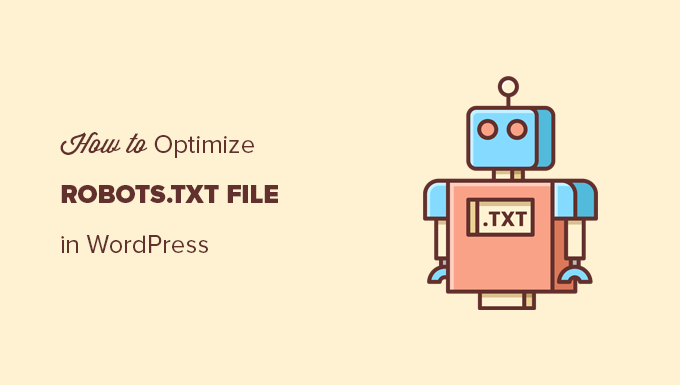
Co to jest plik robots.txt?
Robots.txt to plik tekstowy, który właściciele witryn internetowych mogą utworzyć, aby poinformować boty wyszukiwarek, jak indeksować strony w ich witrynach.
Zazwyczaj jest on przechowywany w katalogu głównym (znanym również jako katalog główny) twojej witryny internetowej. Podstawowy format pliku robots.txt wygląda następująco:
1 2 3 4 5 6 7 | User-agent: [user-agent name]Disallow: [URL string not to be crawled] User-agent: [user-agent name]Allow: [URL string to be crawled] Sitemap: [URL of your XML Sitemap] |
Możesz mieć wiele wierszy instrukcji, aby zezwolić lub nie zezwolić na określone adresy URL i dodać wiele map witryn. Jeśli adres URL nie zostanie zablokowany, boty wyszukiwarek przyjmą, że mogą go indeksować.
Oto jak może wyglądać przykładowy plik robots.txt:
1 2 3 4 5 6 | User-Agent: *Allow: /wp-content/uploads/Disallow: /wp-content/plugins/Disallow: /wp-admin/Sitemap: https://example.com/sitemap_index.xml |
W powyższym przykładzie robots.txt zezwoliliśmy wyszukiwarkom na indeksowanie plików w katalogu uploads naszego WordPressa.
Następnie uniemożliwiliśmy robotom wyszukiwarek indeksowanie wtyczek i katalogów administracyjnych WordPress.
Na koniec podaliśmy adres URL naszej mapy witryny XML.
Czy potrzebujesz pliku robots.txt dla twojej witryny WordPress?
Jeśli nie masz pliku robots.txt, wyszukiwarki nadal będą indeksować twoją witrynę internetową. Nie będziesz jednak w stanie wskazać im stron lub katalogów, których nie powinny indeksować.
Nie będzie to miało większego wpływu, gdy po raz pierwszy uruchamiasz bloga i nie masz dużo treści.
Jednak w miarę rozwoju twojej witryny internetowej i dodawania większej ilości treści, prawdopodobnie będziesz chciał mieć lepszą kontrolę nad tym, jak twoja witryna jest indeksowana i indeksowana.
Oto dlaczego.
Boty wyszukiwarek mają limit indeksowania dla każdej witryny internetowej.
Oznacza to, że indeksują określoną liczbę stron podczas sesji indeksowania. Jeśli wykorzystają swój budżet indeksowania przed zakończeniem indeksowania wszystkich stron w twojej witrynie, wrócą i wznowią indeksowanie w następnej sesji.
Może to spowolnić szybkość indeksowania twojej witryny internetowej.
Możesz to poprawić, uniemożliwiając robotom wyszukiwarek próbę indeksowania niepotrzebnych stron, takich jak strony administracyjne WordPress, pliki wtyczek i katalog motywów.
Wyłączając niepotrzebne strony, oszczędzasz swój limit indeksowania. Pomaga to wyszukiwarkom indeksować jeszcze więcej stron w twojej witrynie i indeksować je tak szybko, jak to możliwe.
Innym dobrym powodem do korzystania z pliku robots.txt jest chęć uniemożliwienia wyszukiwarkom indeksowania wpisu lub strony w twojej witrynie internetowej.
Nie jest to najbezpieczniejszy sposób na ukrycie treści przed opinią publiczną, ale pomoże zapobiec pojawianiu się treści w wynikach wyszukiwania.
Jak wygląda idealny plik robots.txt?
Wiele popularnych blogów korzysta z bardzo prostego pliku robots.txt. Ich treść może się różnić w zależności od potrzeb konkretnej witryny:
1 2 3 4 5 | User-agent: *Disallow:Sitemap: https://www.example.com/post-sitemap.xmlSitemap: https://www.example.com/page-sitemap.xml |
Ten plik robots.txt umożliwia wszystkim robotom indeksowanie całej treści i zapewnia im odnośnik do map witryn XML.
W przypadku witryn WordPress zalecamy następujące reguły w pliku robots.txt:
1 2 3 4 5 6 7 8 | User-Agent: *Allow: /wp-content/uploads/Disallow: /wp-admin/Disallow: /readme.htmlDisallow: /refer/Sitemap: https://www.example.com/post-sitemap.xmlSitemap: https://www.example.com/page-sitemap.xml |
Powoduje to, że boty wyszukiwarek indeksują wszystkie obrazki i pliki WordPress. Uniemożliwia robotom wyszukiwarek indeksowanie obszaru administracyjnego WordPress, pliku readme i ukrytych odnośników partnerskich.
Dodając mapy witryn do pliku robots.txt, ułatwiasz robotom Google znalezienie wszystkich stron w twojej witrynie.
Teraz, gdy już wiesz, jak wygląda idealny plik robots.txt, przyjrzyjmy się, jak możesz utworzyć plik robots.txt w WordPress.
Jak utworzyć plik robots.txt w WordPress?
Istnieją dwa sposoby utworzenia pliku robots.txt w WordPress. Możesz wybrać metodę, która najbardziej Ci odpowiada.
Metoda 1: Edycja pliku robots.txt przy użyciu All in One SEO
All in One SEO, znany również jako AIOSEO, to najlepsza wtyczka WordPress SEO na rynku, używana przez ponad 3 miliony witryn internetowych. Jest łatwa w użyciu i zawiera generator pliku robots.txt.
Aby dowiedzieć się więcej, zobacz naszą szczegółową recenzję AIOSEO.
Jeśli nie masz jeszcze zainstalowanej wtyczki AIOSEO, możesz zapoznać się z naszym przewodnikiem krok po kroku, jak zainstalować wtyczkę WordPress.
Uwaga: Dostępna jest również bezpłatna wersja AIOSEO, która posiada tę funkcję.
Po zainstalowaniu i włączaniu wtyczki można jej używać do tworzenia i edytowania pliku robots.txt bezpośrednio z obszaru administracyjnego WordPress.
Wystarczy przejść do All in One SEO ” Narzędzia, aby edytować twój plik robots.txt.
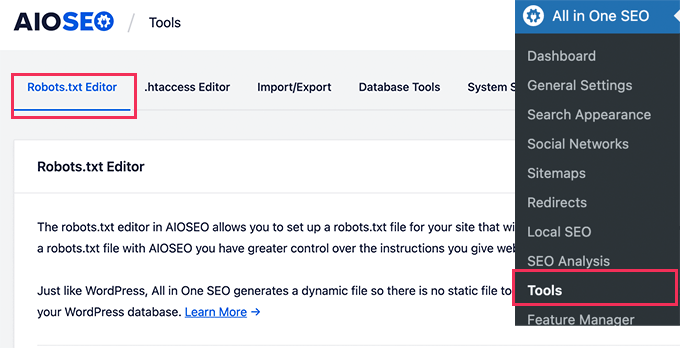
Najpierw musisz włączyć opcję edycji, klikając przełącznik “Enable Custom Robots.txt” na niebiesko.
Po włączeniu tego przełącznika można utworzyć własny plik robots.txt w WordPress.

All in One SEO pokaże twój istniejący plik robots.txt w sekcji “Podgląd pliku robots.txt” na dole ekranu.
Ta wersja wyświetli domyślne reguły dodane przez WordPress.
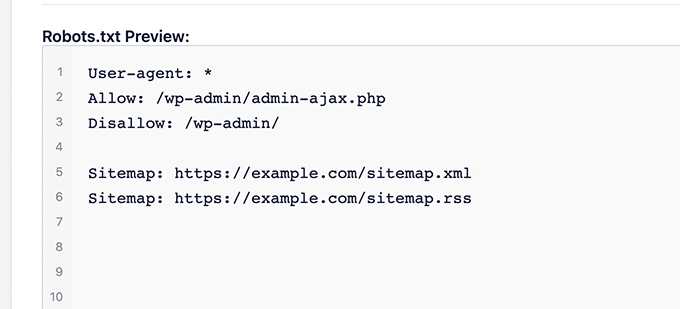
Te domyślne reguły mówią wyszukiwarkom, by nie indeksowały rdzeni plików WordPressa, pozwalają botom indeksować całą treść i udostępniają im odnośnik do map witryn XML twojej witryny.
Teraz możesz dodać własne konfiguratory, aby ulepszyć swój plik robots.txt pod kątem SEO.
Aby dodać regułę, wpisz agenta użytkownika w polu “Agent użytkownika”. Użycie znaku * spowoduje zastosowanie reguły do wszystkich agentów użytkownika.
Następnie wybierz, czy chcesz “Zezwalać”, czy “Zezwalać” na indeksowanie przez wyszukiwarki.
Następnie wpisz nazwę pliku lub ścieżkę katalogu w polu “Ścieżka katalogu”.
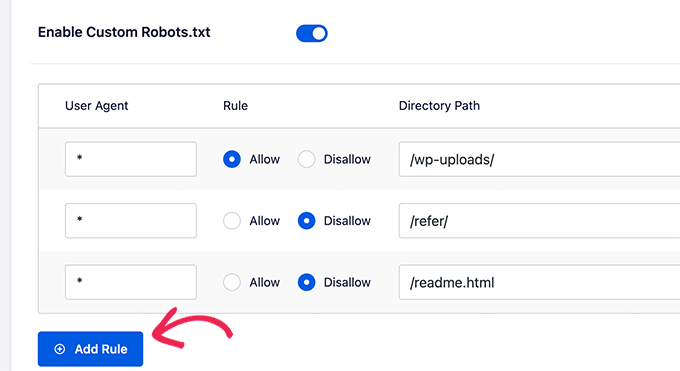
Reguła zostanie automatycznie zastosowana do twojego pliku robots.txt. Aby dodać kolejną regułę, wystarczy kliknąć przycisk “Dodaj regułę”.
Zalecamy dodawanie reguł do momentu utworzenia idealnego formatu pliku robots.txt, który udostępniliśmy powyżej.
Twój konfigurator będzie wyglądał następująco.
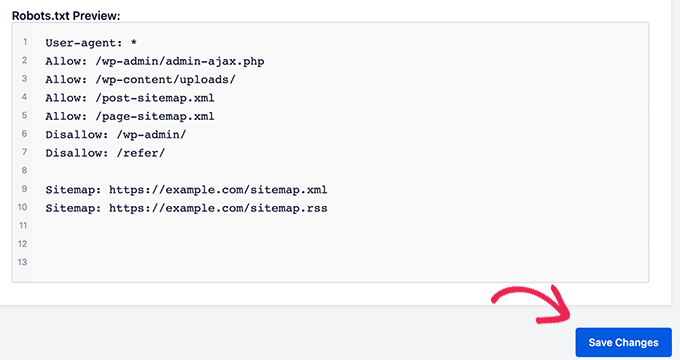
Po zakończeniu nie zapomnij kliknąć przycisku “Zapisz zmiany”, aby zapisać twoje zmiany.
Metoda 2: Edycja pliku robots.txt przy użyciu WPCode
WPCode to potężna wtyczka fragmentów kodu, która pozwala łatwo i bezpiecznie dodawać własny kod do twojej witryny internetowej.
Zawiera również przydatną funkcję, która pozwala szybko edytować plik robots.txt.
Uwaga: Istnieje również darmowa wtyczka WPCode, ale nie zawiera ona funkcji edytora plików.
Pierwszą rzeczą, którą musisz zrobić, jest zainstalowanie wtyczki WPCode. Aby uzyskać instrukcje krok po kroku, zobacz nasz przewodnik dla początkujących, jak zainstalować wtyczkę WordPress.
Po włączaniu należy przejść do strony WPCode ” Edytor plików. Tam wystarczy kliknąć kartę “robots.txt”, aby edytować plik.
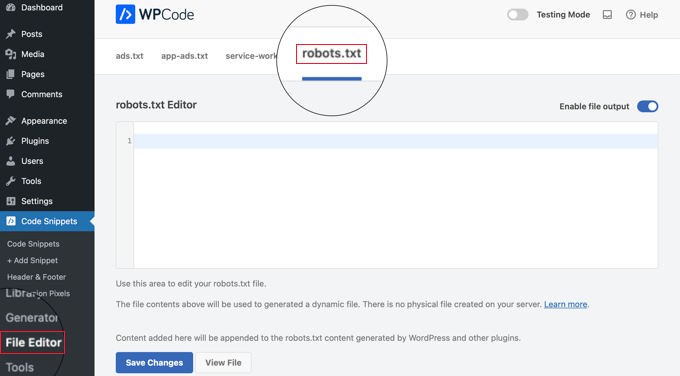
Teraz możesz wkleić lub wpisać treść pliku robots.txt.
Po zakończeniu upewnij się, że kliknąłeś przycisk “Zapisz zmiany” u dołu strony, aby zapisać ustawienia.
Metoda 3: Ręczna edycja pliku Robots.txt przy użyciu FTP
W przypadku tej metody konieczne będzie użycie klienta FTP do edycji pliku robots.txt. Alternatywnie możesz użyć menedżera plików dostarczonego przez twój hosting WordPress.
Wystarczy połączyć się z plikami twojej witryny internetowej WordPress za pomocą klienta FTP.
Po wejściu do środka będziesz mógł zobaczyć plik robots.txt w katalogu głównym twojej witryny internetowej.
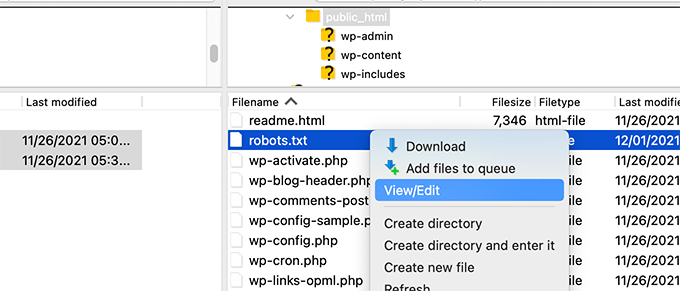
Jeśli go nie widzisz, prawdopodobnie nie masz pliku robots.txt.
W takim przypadku możesz po prostu go utworzyć.
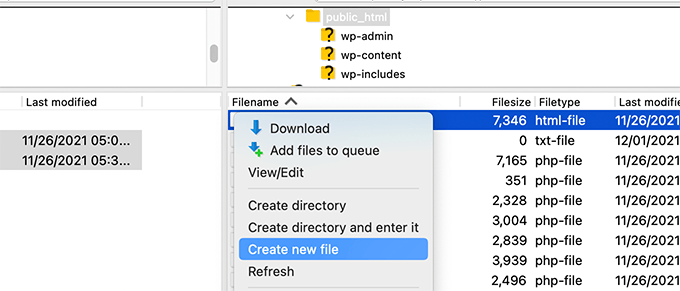
Robots.txt to zwykły plik tekstowy, co oznacza, że możesz pobrać go na swój komputer i edytować za pomocą dowolnego edytora tekstu, takiego jak Notatnik lub TextEdit.
Po zapisaniu zmian możesz przesłać plik robots.txt z powrotem do katalogu głównego witryny internetowej.
Jak przetestować twój plik robots.txt?
Po utworzeniu twojego pliku robots.txt zawsze warto przetestować go za pomocą narzędzia do testowania pliku robots.txt.
Istnieje wiele narzędzi do testowania pliku robots.txt, ale my zalecamy korzystanie z tego dostępnego w Google Search Console.
Po pierwsze, twoja witryna internetowa musi być odnośnikiem do Google Search Console. Jeśli jeszcze tego nie zrobiłeś, zapoznaj się z naszym przewodnikiem na temat dodawania Twojej witryny WordPress do Google Search Console.
Następnie można skorzystać z narzędzia do testowania robotów Google Search Console.
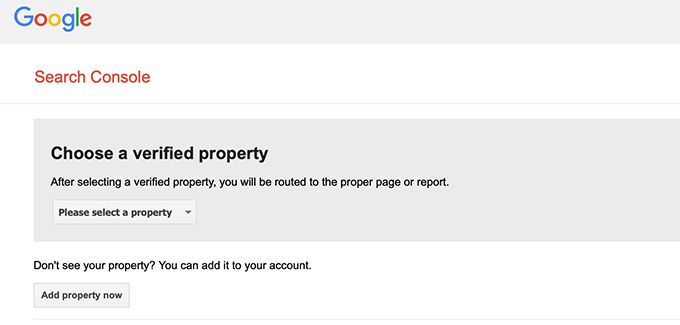
Wystarczy wybrać twój obiekt z rozwijanej listy.
Narzędzie automatycznie pobierze plik robots.txt twojej witryny internetowej i podświetli błędy i ostrzeżenia, jeśli takie znajdzie.
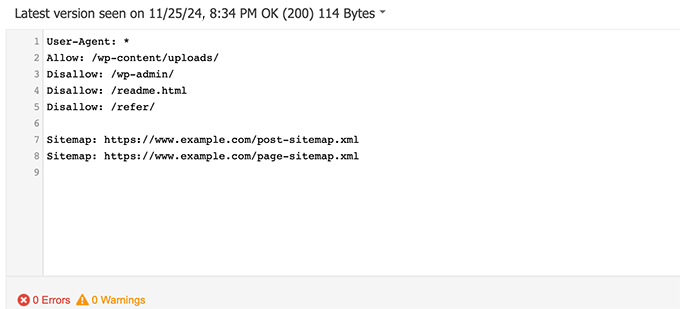
Przemyślenia końcowe
Celem optymalizacji twojego pliku robots.txt jest uniemożliwienie wyszukiwarkom indeksowania stron, które nie są publicznie dostępne. Na przykład strony w twoim katalogu wtyczek wp lub strony w katalogu administracyjnym WordPress.
Powszechnym mitem wśród ekspertów SEO jest to, że blokowanie kategorii, tagów i stron archiwalnych WordPress poprawi szybkość indeksowania i spowoduje szybsze indeksowanie i wyższą ocenę.
Nie jest to prawdą. Jest to również niezgodne z wytycznymi Google dla webmasterów.
Zalecamy przestrzeganie powyższego formatu pliku robots.txt w celu utworzenia pliku robots.txt dla twojej witryny internetowej.
Przewodniki ekspertów dotyczące korzystania z pliku robots.txt w WordPressie
Teraz, gdy już wiesz, jak zoptymalizować twój plik robots.txt, możesz chcieć zobaczyć kilka innych artykułów związanych z używaniem robots.txt w WordPress.
- Słowniczek: Robots.txt
- Jak ukryć stronę WordPress przed Google?
- Jak powstrzymać wyszukiwarki przed indeksowaniem witryny WordPress
- Jak trwale usunąć witrynę WordPress z Internetu?
- Jak łatwo ukryć (noindex) pliki PDF w WordPress?
- Jak naprawiono błąd “Googlebot nie może uzyskać dostępu do plików CSS i JS” w WordPress?
- Jak poprawnie skonfigurować All in One SEO dla WordPress (najlepszy przewodnik)
Mamy nadzieję, że ten artykuł pomógł ci dowiedzieć się, jak zoptymalizować twój plik robots.txt WordPress pod kątem SEO. Zachęcamy również do zapoznania się z naszym kompletnym przewodnikiem SEO WordPress i wyborem najlepszych narzędzi SEO WordPress, które pomogą ci rozwinąć twoją witrynę internetową.
If you liked this article, then please subscribe to our YouTube Channel for WordPress video tutorials. You can also find us on Twitter and Facebook.





Steve
Thanks for this – how does it work on a WP Multisite thou?
WPBeginner Support
For a multisite, you would need to have a robots.txt file in the root folder of each site.
Admin
Pacifique Ndanyuzwe
My wordpress site is new and my robot.txt by default is
user-agent: *
Disallow: /wp-admin/
Allow: /wp-admin/admin-ajax.php
I want google to crawl and index my content. Is that robot.txt okay?
WPBeginner Support
You can certainly use that if you wanted
Admin
Ritesh Seth
Great Airticle…
I was confused from so many days about Robots.txt file and Disallow links. Have copied the tags for robots file. Hope this will solve the issue of my Site
WPBeginner Support
We hope our article will help as well
Admin
Kurt
The files in the screenshots of your home folder are actually located under the public_html folder under my home folder.
I did not have a /refer folder under my public_html folder.
I did not have post or page xml files anywhere on my WP account.
I did include an entry in the robots.txt file I created to disallow crawling my sandbox site. I’m not sure that’s necessary since I’ve already selected the option in WP telling crawlers not to crawl my sandbox site, but I don’t think it will hurt to have the entry.
WPBeginner Support
Some hosts do rename public_html to home which is why you see it there. You would want to ensure Yoast is active for the XML files to be available. The method in this article is an additional precaution to help with preventing crawling your site
Admin
Ahmed
Great article
WPBeginner Support
Thank you
Admin
ASHOK KUMAR JADON
Hello, such a nice article you solve my problem. So Thank You so much
WPBeginner Support
Glad our article could help
Admin
Elyn Ashton
User-agent: *
Disallow: /wp-admin/
Allow: /wp-admin/admin-ajax.php <– This is my robot.txt code but im confuse why my /wp-admin is index? How to no index it?
WPBeginner Support
If it was indexed previously you may need to give time for the search engine’s cache to clear
Admin
Ashish kumar
This website really inspire me to start a blog .Thank you lost of tema.this website each and every article have rich of information and explanation.when i have some problem at first i visit this blog . Thank You
WPBeginner Support
Glad our articles can be helpful
Admin
Anna
I am trying to optimise robots for my website using Yoast. However Tools in Yoast does not have the option for ‘File Editor’.
There are just two options
(i) Import and Export
(ii) Bulk editor
May you please advise how this can be addressed. Could it be that I am on a free edition of Yoast?
WPBeginner Support
The free version of Yoast still has the option, your installation may be disallowing file editing in which case you would likely need to use the FTP method.
Admin
Emmanuel Husseni
I really find this article helpful because I really don’t know much on how robot.txt works but now I do.
pls what I don’t understand is how do I find the best format of robot.txt to use on my site (I mean one that works generally)?
I noticed lots of big blogs I check ranking high on search engine uses different robot.txt format..
I’ll be clad to see a reply from you or just anyone that can help
Editorial Staff
Having a sitemap and allowing the areas that need to be allowed is the most important part. The disallow part will vary based on each site. We shared a sample in our blog post, and that should be good for most WordPress sites.
Admin
WPBeginner Support
Hey Emmanuel,
Please see the section regarding the ideal robots.txt file. It depends on your own requirements. Most bloggers exclude WordPress admin and plugin folders from the crawl.
Admin
Emmanuel Husseni
Thank you so much.
now I understand. I guess I’ll start with the general format for now.
jack
Well written article, I recommend the users to do sitemap before creating and enabling their ROBOTS text it will help your site to crawl faster and indexed easily.
Jack
Connie S Owens
I would like to stop the search engines from indexing my archives during their crawl.
Emmanuel Nonye
Thanks alot this article it was really helpful
Cherisa
I keep getting the error message below on google webmaster. I am basically stuck. A few things that were not clear to me on this tutorial is where do I find my site’s root files, how do you determine if you already have a “robots.txt” and how do you edit it?
WPBeginner Support
Hi Cherisa,
Your site’s root folder is the one that contains folders like wp-admin, wp-includes, wp-content, etc. It also contains files like wp-config.php, wp-cron.php, wp-blogheader.php, etc.
If you cannot see a robots.txt file in this folder, then you don’t have one. You can go a head and create a new one.
Admin
Cherisa
Thank you for your response. I have looked everywhere and can’t seem to locate these root files as you describe. Is there a path directory I can take that leads to this folder. Like it is under Settings, etc?
Devender
I had a decent web traffic to my website. Suddenly dropped to zero in the month of May. Till now I have been facing the issue. Please help me to recover my website.
Haris Aslam
Hello There Thank you For This Information, But I Have A Question
That I Just Create The Sitemap.xml and Robots.txt File, & Its Crawling well. But How Can I Create “Product-Sitemap.xml”
There is all list of product in sitemap.xml file. Do I Have To Create Product-sitemap.xml separately?
and submit to google or bing again ?
Can You please Help me out…
Thank You
Mahadi Hassan
I have a problem on robots.txt file setting. Only one robots.txt is showing for all websites. Please help me to show separate robots.txt file of all websites. I have all separate robots.txt file of all individual website. But only one robots.txt file is showing in browser for all websites.
Debu Majumdar
Please explain why did you include
Disallow: /refer/
in the beginner Robots.txt example? I do not understand the implications of this line. Is this important for the beginner? You have explained the other two Disallowed ones.
Thanks.
WPBeginner Support
Hi Debu,
This example was from WPBeginner’s robots.txt file. At WPBeginner we use ThirstyAffiliates to manage affiliate links and cloak URLs. Those URLs have /refer/ in them, that’s why we block them in our robots.txt file.
Admin
Evaristo
How can I put all tags/mydomain.Com in nofollow? In robots.txt to concentrate the link Juice? Thanks.
harsh kumar
hey,,i am getting error in yoast seo regarding site map..once i click on fix it ,,,it’s coming again..my site html is not loading properly
Tom
I’ve just been reviewing my Google Webmaster Tools account and using the Search Console, I’ve found the following:
Page partially loaded
Not all page resources could be loaded. This can affect how Google sees and understands your page. Fix availability problems for any resources that can affect how Google understands your page.
This is because all CSS stylesheets associated with Plugins are disallowed by the default robots.txt.
I understand good reasons why I shouldn’t just make this allowable, but what would be an alternative as I would suspect the Google algorithms are marking down the site for not seeing these.
Suren
Hi,
Whenever, I search my site on the google this text appears below the link: “A description for this result is not available because of this site’s robots.txt”
How, can i solve this issue?
Regards
WPBeginner Support
Hi Suren,
Seems like someone accidentally changed your site’s privacy settings. Go to Settings » Reading page and scroll down to ‘Search engine visibility’ section. Make sure that the box next to is unchecked.
Admin
Divyesh
Hello
As i seen in webmaster tool, i got robot.txt file like below :
User-agent: *
Disallow: /wp-admin/
Allow: /wp-admin/admin-ajax.php
let me know is that okey ? or should i use any other ?
John Cester
I want to know, does it a good idea to block (disallow) “/wp-content/plugins/” in robots.tx? Every time i remove a plugin it shows 404 error in some pages of that plugin.
Himanshu singh
I loved this explanation. As a beginner I was very confused about robot.txt file and its uses. But now I know what is its purpose.
rahul
in some robot.txt file index.php has been disallowed. Can you explain why ? is it a good practice.
Waleed Barakat
Thanks for passing by this precious info.
Awais Ahmed
Can you please tell me why this happening on webmaster tool:
Network unreachable: robots.txt unreachableWe were unable to crawl your Sitemap because we found a robots.txt file at the root of your site but were unable to download it. Please ensure that it is accessible or remove it completely.
robots.txt file exist but still
Dozza
Interesting update from the Yoast team on this at
Quote: “The old best practices of having a robots.txt that blocks access to your wp-includes directory and your plugins directory are no longer valid.”
natveimaging
Allow: /wp-content/uploads/
Shouldn’t this be?
Disallow: /wp-content/uploads/
Because you are aware that google will index all your uploads pages as public URLs right? And then you will get slapped with errors for the page itself. Is there something I am missing here?
nativeimaging
Overall, its the actual pages that google crawls to generate image maps, NOT the uploads folders. Then you would have a problem of all the smaller image sizes, and other images that are for UI will also get indexed.
This seems to be the best option:
Disallow: /wp-content/uploads/
If i’m incorrect, please explain this to me so I can understand your angle here.
Jason
My blog url not indexing do i need to change my robots.txt?
Im using this robots.txt
iyan
how to create robot txt which is ONLY allow index for page and Post.. thanks
Simaran Singh
I am not sure what’s the problem but my robots.txt has two versions.
One at http://www.example.com/robots.txt and second at example.com/robots.txt
Anybody, please help! Let me know what can be the possible cause and how to correct it?
WPBeginner Support
Most likely, your web host allows your site to be accessed with both www and non-www urls. Try changing robots.txt using an FTP client. Then examine it from both URLs if you can see your changes on both URLs then this means its the same file.
Admin
Simaran Singh
Thanks for the quick reply. I have already done that, but I am not able to see any change. Is there any other way to resolve it?
Martin conde
Yoasts blogpost about this topic was right above yours in my search so of course I checked them both. They are contradicting each other a little bit.. For example yoast said that disallowing plugin directories and others, might hinder the Google crawlers when fetching your site since plugins may output css or js. Also mentioned (and from my own experience), yoast doesn’t add anything sitemap related to the robots.txt, rather generates it so that you can add it to your search console. Here is the link to his post, maybe you can re-check because it is very hard to choose whose word to take for it
MM Nauman
As I’m Not Good in Creating this Robotstxt file So Can I use your Robots.txt file by changing the parameters like url and sitemap of my site is it good? or should I create a different one
Mohit Chauhan
Hi,
Today i got this mail from Google “Googlebot cannot access CSS and JS files”…what can be the solution?
Thanks
Parmod
Let me guess… You are using CDN services to import CSS and JS files.
or
It may be possible that you have written wrong syntax in these file.
Rahul
I have a question about adding Sitemaps. How can I add Yahoo and Bing Sitemap to Robots file and WordPress Directory?
Gerbrand Petersen
Thanks for the elaborate outline of using the robots file. Does anyone know if Yahoo is using this robots.txt too, and does it obey the rules mentioned in the file? I ask this since I have a “Disallow” for a certain page in my file, but I do receive traffic coming from Yahoo on that page. Nothing from Google, as it should be. Thanks in advance.
Erwin
correction…
“If you are using Yoast’s WordPress SEO plugin or some other plugin to generate your XML sitemap, then your plugin will try to automatically add your sitemap related lines into robots.txt file.”
Not true. WordPress SEO doesn’t add the sitemap to the robots.txt
“I’ve always felt linking to your XML sitemap from your robots.txt is a bit nonsense. You should be adding them manually to your Google and Bing Webmaster Tools and make sure you look at their feedback about your XML sitemap. This is the reason our WordPress SEO plugin doesn’t add it to your robots.txt.”
https://yoast.com/wordpress-robots-txt-example/
Also more recommended is not to disallow the wp-plugins directory (reasons see Yoast’s post)
And personally I like to simply remover the readme.txt file…
hyma
I understood it robots.txt file and use of robots file. What is the site map how do I create sitemap for my site.
Rick R. Duncan
After reading Google’s documentation I’m under the impression that the directive to use in the robots.txt file is disallow which only tells the bots what they can and cannot crawl. It does not tell them what can and cannot be indexed. You need to use the noindex robots meta tag to have a page noindexed.
Nitin
really good article for seo optimized robots.txt file. But I need you to give a tutorial on how to upload robots.txt file to server. As, being a beginner it seems to be a drastic problem to upload that file.
By the way thanks to share such beneficial information.
-Nitin
Parmod
Upload it to your server/public_hmtl/(Your-site-name) … in this folder
Jenny
What is the best way to add code to HTTacess to block multiple spam bot refers for their url and Ip address if no URL is given
I know if you get wrong syntax when doing httacess it can take your site off line I am a newbie and need to block these annoying multiple urls from Russia, China, Ukraine etc.
Many thanks
Hazel Andrews
Thanks for those tips….robot txt files now amended! yay!
Rahat
why have to add Allow: !!!
if I mention only which have to Disallow that enough. Don’t have to write code for Allow because Googlebot or Bingbot will crawl all other thing automatically.
So why should I use Allow again?
Connor Rickett
Since lacking the Robots.txt file doesn’t stop the site from being crawled, I find myself curious: Is there any sort of hard data on exactly how much having the file will improve SEO performance?
I did a quick Google search, and didn’t see any sort of quantitative data on it. It’s about half a million articles saying, “Hey, this makes SEO better!” but I’d really like to know what we’re talking about here, even generally.
Is this a 5% boost? 50? 500?
WPBeginner Support
Search engines don’t share such data. While not having a robots.txt file does not stop search engines from crawling or indexing a website. However, it is a recommended best practice.
Admin
Connor Rickett
Thanks for taking the time to get back to me, I appreciate it!
JD Myers
Good timing on this. I was trying to find this information just yesterday.
The reason I was searching for it is that Google Webmaster tools was telling me that they could not properly crawl my site because I was blocking various resources needed for the proper rendering of the page.
These resources included those found in /wp-content/plugins/
After I allowed this folder, the warning disappeared.
Any thoughts on this?
WPBeginner Support
You can safely ignore those warnings. It is only a warning if you actually had content there that you would want to get indexed. Sometimes users have restricted search bots and have forgotten about it. These warnings come in handy in those situations.
Admin
Chetan jadhav
I have a question that many people out there use static sitemap, and you know what they have wordpress site. Should we us static or sitemap genrated by worpress.
Wilton Calderon
NIce, i like the way Wpbeginner have, and with that rank in alexa, look to me is one of the best way to sue robots.txt..
Brigitte Burke
what does my robots.txt file mean if it looks like this?
User-agent: *
Disallow: /wp-admin/
Disallow: /wp-includes/
Disallow: /xmlrpc.php
Editorial Staff
It’s just saying that search engines should not index your wp-admin folder, wp-includes folder, and the xml-rpc file. Sometimes disallowing /wp-includes/ can block certain scripts for search engines specially if your site is using those scripts. This can hurt your SEO.
The best thing to do is go to Google Webmaster Tools and fetch your website as a bot there. If everything loads fine, then you have nothing to worry about. If it says that scripts are blocked, then you may want to take out the wp-includes line.
Admin
hercules
I see no logic in your idea about having a script within the includes directory that can be used by a crawn / robot .. and another, if there is an isolated case, it is better after specify the default wordpress allow this file you imagine that search engines use his scripts! after all, wordpress has certainly not by default an robots.txt anti serch engines!!!!